Dive into the life and lore of one of the most intriguing creatures beneath the waves. – the sperm whale. These behemoths of the deep have fascinated humans for centuries, from their epic battles in literary classics to their critical role in the marine ecosystem.
Whether you’re an avid marine enthusiast or simply curious about the natural world, join us as we uncover the secrets of the sperm whale, offering a glimpse into the lives of these majestic mammals and the efforts to ensure their survival for generations to come.
What is the Sperm Whale
Picture this: a massive, enigmatic creature, ruling the deep blue with its colossal size and mysterious ways. The sperm whale isn’t just any marine mammal; it’s the largest toothed predator on the planet.
These giants are the stuff of maritime legends, dominating the ocean’s depths like underwater royalty. With brains that are five times heavier than ours, these whales are not just brawn; they’re also brains, boasting complex social structures and communication skills that would put any social network to shame.
They’re the deep-diving champions of the sea, capable of plunging to depths over 2,000 meters to snack on their favorite treat: squid. This isn’t just a creature; it’s an oceanic marvel, playing a crucial role in the marine ecosystem by influencing the distribution of its prey and even impacting global carbon cycles. Fascinating, right?
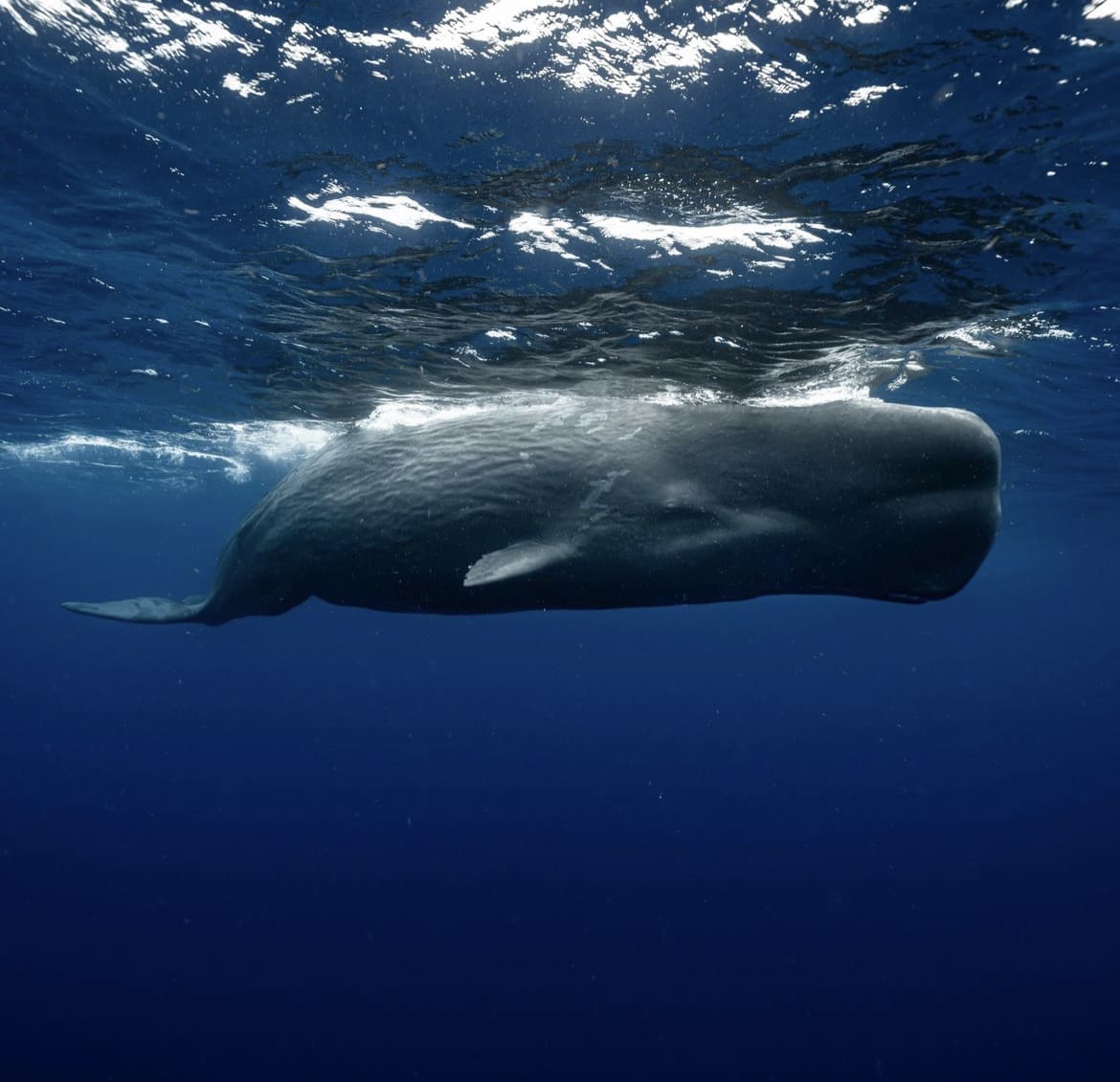
Why are they called Sperm Whales
Now, onto a question that’s tickled many a mind: why the heck are they called “sperm whales”? No, it’s not what you think. The name comes from the spermaceti organ, a large, waxy reservoir in the whale’s head. Back in the day, whalers mistakenly thought this substance was sperm (yip, you heard that right).
This organ is actually full of a substance called spermaceti, once prized for making candles, soaps, and cosmetics. It’s this very organ that gives the sperm whale its distinctive, block-shaped forehead, setting it apart from all other marine creatures. So, while the name might raise eyebrows, it speaks volumes about the whale’s unique anatomy and the human history intertwined with these majestic beings.
What do Sperm Whales look like
Let’s paint a picture of the sperm whale. Imagine a creature so oddly shaped that it looks like it was designed by a committee: a huge, blocky head that makes up about one-third of its body length, small, paddle-like flippers, and a wrinkled, dark gray to black skin that looks like it’s been through the wringer.
The sperm whale’s head is its most distinguishing feature, housing that spermaceti organ we talked about. And then there’s the blowhole, uniquely positioned on the left side of the head and angled forward, making their blow a distinctive, bushy, angled spray. If you’re picturing something out of a sci-fi novel, you’re not far off. These creatures are as alien as they are earthly, embodying the mysteries of the deep in their very appearance.
Diving with a young sperm whale | @pelagic.pickle
How Big are Sperm Whales
So, how massive are we talking? When it comes to sperm whales, the word “huge” takes on a whole new meaning. Adult males can stretch up to a whopping 20 meters (that’s about 66 feet for those who shun the metric system) and can weigh up to an astounding 57,000 kilograms—roughly the heft of 40 small cars.
Females are a bit smaller, typically maxing out around 12 meters (39 feet), but don’t let that fool you; they’re still formidable beasts of the sea. This size isn’t just for show; it’s a critical part of their deep-sea diving toolkit, allowing them to withstand the crushing pressures of the ocean depths to hunt their prey. Next time you’re feeling small, just remember: you’re never as small as a human next to a sperm whale.
Sperm Whale Teeth
Moving on to one of the sperm whale’s most iconic features: those pearly whites. Or, well, not so pearly. Each tooth is like a hefty, ivory cone, capable of reaching lengths of up to 20 centimeters (about 8 inches). These aren’t just for show; they’re crucial for grappling with slippery squid in the pitch-black depths.
But here’s a curveball: not all sperm whales actively use their teeth for feeding. Scientists believe that in many cases, these giants simply suck their squid prey whole, like a kid slurping spaghetti. Nonetheless, those teeth can be a formidable weapon, and in males, they’re often used in displays of dominance and combat over mates. It’s a tough world out there in the deep blue, and those teeth are a testament to the sperm whale’s survival in it.

Sperm Whale Tails
Now, let’s talk about the business end of a sperm whale: the tail. If the head is all about brains and brawn, the tail is where the action happens. Spanning an impressive width of up to 4 meters (13 feet), the tail flukes are the powerhouse of the sperm whale, propelling it through the water and enabling those awe-inspiring deep dives.
Watching a sperm whale dive is something of a spiritual experience, as it lifts its tail high above the waterline, a silent salute before plunging into the abyss. These tails aren’t just for show; they’re finely tuned instruments, allowing for precise movements and swift turns in the deep-sea ballet of survival.
Whether it’s outmaneuvering predators, diving deep for dinner, or simply cruising the ocean highways, the sperm whale’s tail is a marvel of marine engineering.
What do Sperm Whales eat?
Diving deeper into the diet of these oceanic behemoths, let’s talk grub. Sperm whales have a one-track mind when it comes to their meals: squid. But not just any squid—the giant and colossal varieties that lurk in the ocean’s twilight zone.
These whales are the ultimate deep-sea diners, plunging to depths of over 2,000 meters (that’s more than a mile down!) to hunt. Their diet isn’t limited to squid, though; they’re also known to snack on a variety of deep-sea fish and even the occasional octopus. The hunt is no easy feat; it requires incredible navigation and hunting skills, utilizing echolocation to zero in on their prey in the pitch-black depths.
Imagine navigating a pitch-dark maze, chasing after a meal that’s trying its best to escape. It’s high stakes dining where the sperm whale reigns supreme.
Free diving with a sperm whale | @maalu_i
Sperm Whale Social Structure
Now, let’s get into the social life of sperm whales, which is surprisingly complex and, dare I say, relatable. Sperm whales are the extroverts of the cetacean world, forming tight-knit groups known as pods.
These aren’t just casual acquaintances; they’re deep, meaningful connections that can last a lifetime. Female-led pods consist of mothers, daughters, and aunties, all banding together in a matriarchal society that would make any feminist proud. They share responsibilities like caring for the young and protecting the pod from predators.
Male sperm whales, on the other hand, are the lone wolves of the ocean, typically roaming solo or in bachelor groups until it’s time to mate. It’s a fascinating dynamic, with deep bonds and intricate communication networks, proving that even in the vast, open ocean, community and family are everything.
How do Sperm Whales reproduce?
When it comes to romance, sperm whales take things slow. Mating involves a delicate dance of gentle nudging, stroking, and vocalizing, with males vying for the attention of females through displays of affection rather than aggression. It’s all about chemistry and making the right moves.
After a successful courtship, the female embarks on a 14 to 16-month gestation journey, culminating in the birth of a single calf. This isn’t just a drop-and-go situation; sperm whale calves are the apple of their mother’s eye, staying close and nursing for several years before gradually gaining independence.
But even as they grow, the bonds remain, with young whales learning the ropes of deep-sea life under the watchful eyes of their mothers and other pod members. It’s a community effort, ensuring that each new generation is ready to take on the world—or, in this case, the ocean’s depths.
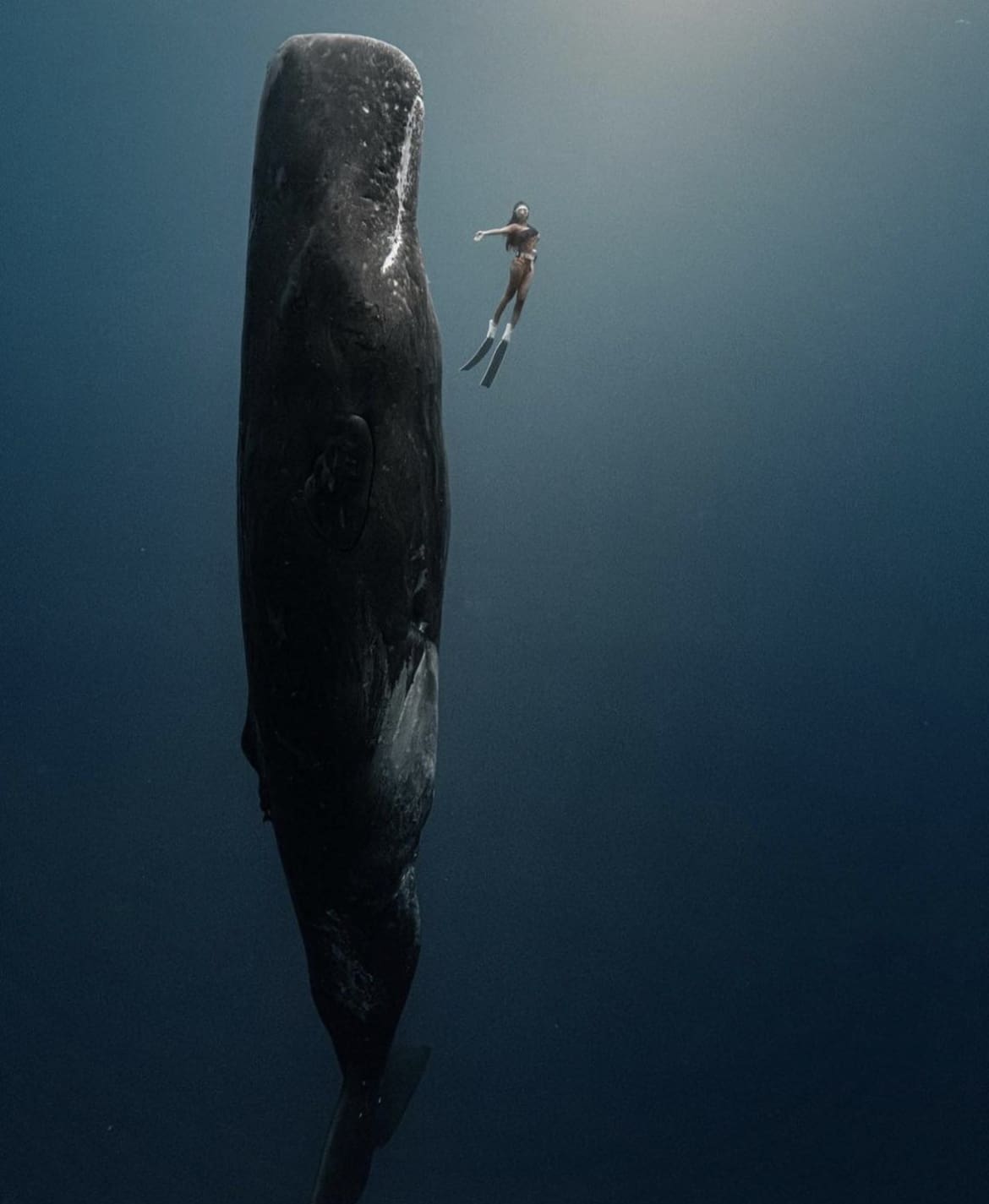
How long do Sperm Whales live?
Ever wonder about the lifespan of these ocean giants? Sperm whales have some serious longevity, living up to 70 years or more. That’s a whole lot of ocean adventures and deep dives.
Their life journey is marked by phases, from the playful and dependent calves to the wise and wandering adults. Males reach their prime in their 30s and 40s, becoming more solitary as they age, while females stick with their families, passing down generations of knowledge and social bonds.
This longevity contributes to their complex social structures and deep familial ties, making each pod a rich tapestry of histories and relationships. It’s a testament to the resilience of sperm whales, navigating the vast and often unforgiving ocean for decades.
Are Sperm Whales aggressive?
Let’s tackle a big question: are these behemoths of the deep aggressive? Despite their imposing size and formidable teeth, sperm whales are generally gentle giants, especially towards humans.
There’s little evidence to suggest they pose any threat to us. In fact, historical accounts and modern encounters often describe them as curious and even playful around humans. However, when threatened or competing for mates, males can show aggression towards each other, using their massive heads in powerful displays of strength.
But these instances are more about posturing and establishing dominance within their social structures than true aggression. So, while they’re certainly capable of defending themselves, sperm whales prefer peace and quiet in the deep blue.
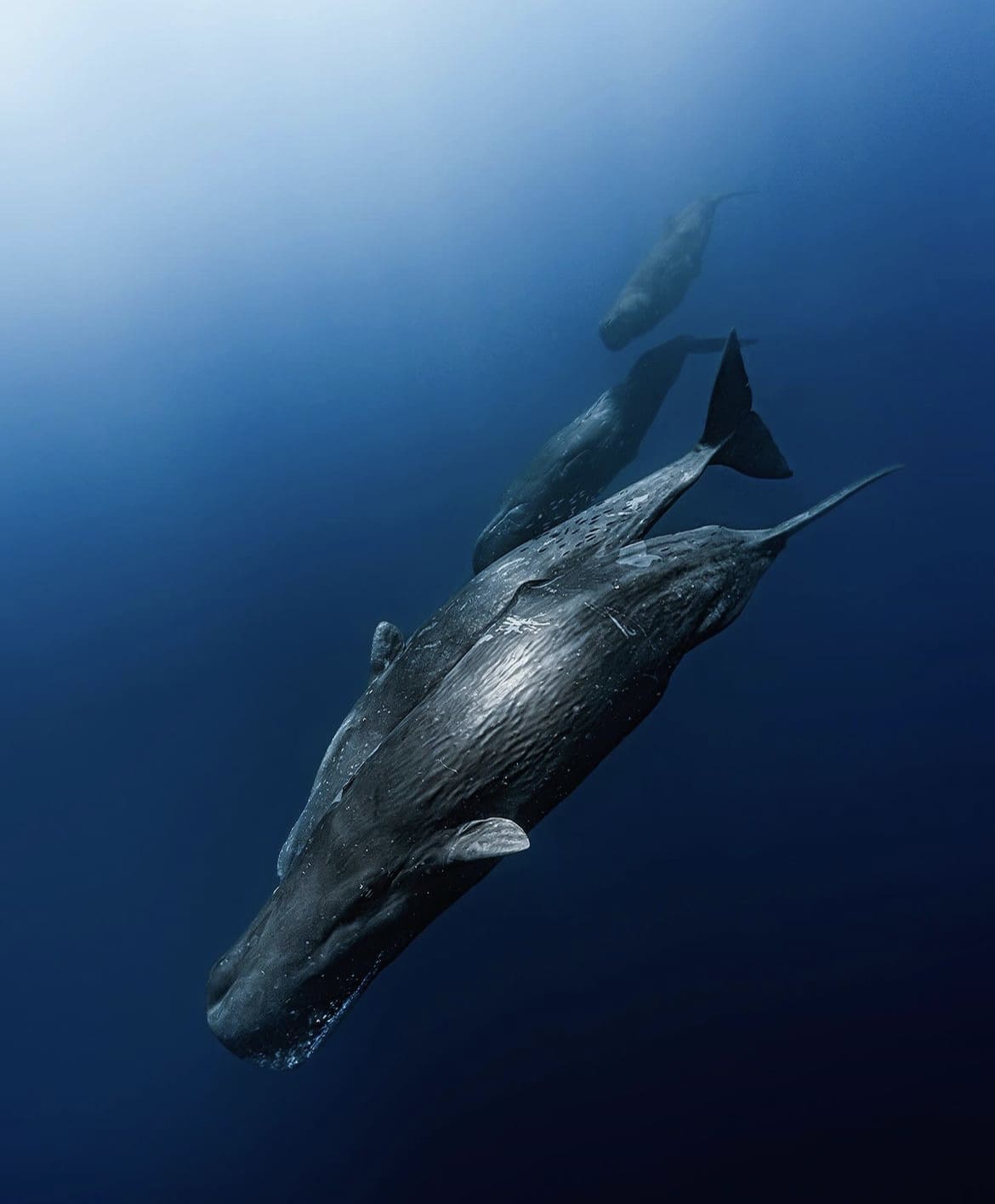
Are Sperm Whales territorial?
Moving on, let’s dive into whether sperm whales have a “This is my turf!” attitude. The answer? Not really. Unlike some animals that fiercely defend specific territories, sperm whales are nomadic voyagers of the ocean.
Their “territory” is the vast, open water, where they follow the buffet of deep-sea squid, their favorite snack. They roam across the oceans, from the equator to the edges of the ice in polar regions, without a fixed address. This doesn’t mean they wander aimlessly; their migrations are purposeful, driven by the search for food, breeding opportunities, and warmer waters for birthing.
But as for drawing lines in the ocean sand and saying “back off”? That’s not their style. Sperm whales are all about the journey, not the destination.
Sperm Whale Migration
Diving into the nomadic life of sperm whales, their migration patterns are like epic tales of the sea, spanning thousands of miles. These whales are the ultimate travelers, moving in tune with the ocean’s rhythms and the seasonal abundance of squid.
Their migrations are largely driven by two things: food and breeding. When it’s time to feast, they head to colder waters, rich in the squid that make up the bulk of their diet. Come breeding season, it’s off to warmer, tropical waters where the environment is just right for giving birth and raising their young.
This constant movement between feeding and breeding grounds showcases the sperm whale’s adaptability, ensuring they’re always at the right place at the right time for the best buffet or the safest nurseries.

Where do Sperm Whales live?
So, where can you find these globe-trotting giants? Pretty much all over the world’s oceans, from the icy waters near the poles to the warm equatorial seas. Sperm whales don’t discriminate when it comes to latitude, but they do have a preference for deep waters off continental shelves and oceanic trenches—places where their favorite meals like to hang out.
While they roam widely, certain areas are known hotspots for spotting sperm whales, including the waters off the Azores, the coast of Sri Lanka, and parts of the Pacific Ocean near California and the Sea of Cortez. Their global distribution is a testament to the sperm whale’s ability to adapt to a variety of marine environments, making them one of the ocean’s most widespread inhabitants.
How many Sperm Whales are there in the Ocean?
Now, onto the big question: just how many sperm whales are out there? Estimating population sizes in the vastness of the oceans is no small feat, but current data suggests there are roughly 200,000 to 250,000 sperm whales worldwide.
While these numbers may seem large, it’s important to remember that sperm whales were heavily hunted in the 19th and 20th centuries, severely impacting their numbers. Conservation efforts have helped stabilize some populations, but they still face threats from human activities and environmental changes.
The current population reflects a delicate balance, a reminder of the importance of ongoing conservation and research efforts to ensure these majestic creatures continue to thrive in the world’s oceans.
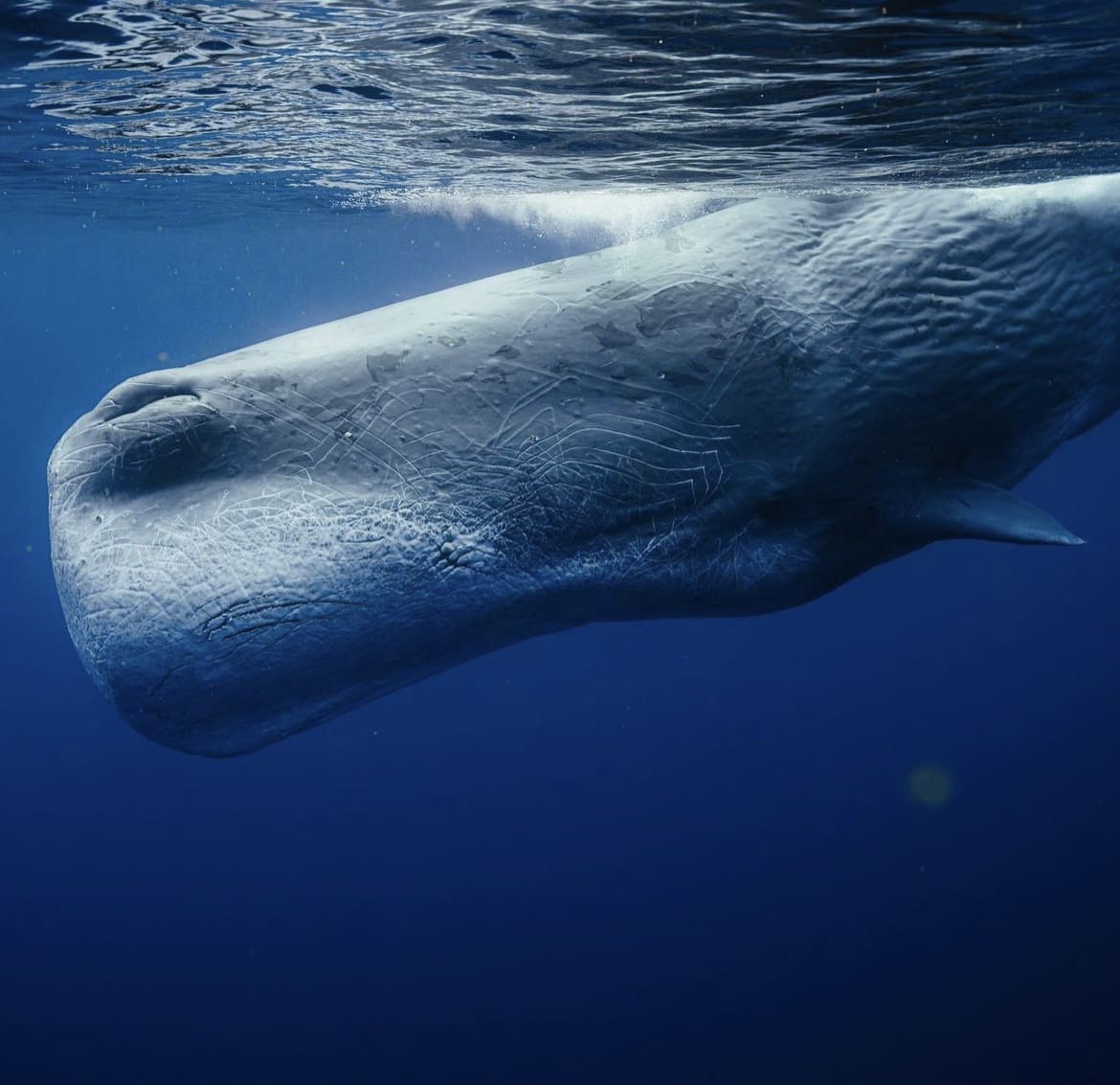
Are Sperm Whales Endangered
The conservation status of sperm whales has been a rollercoaster of highs and lows. Currently listed as “Vulnerable” by the International Union for Conservation of Nature (IUCN), these magnificent mammals have come a long way from the brink of disaster brought on by whaling.
The global ban on commercial whaling has significantly helped their populations recover, but they’re not out of the woods yet. Modern threats like ocean pollution, ship strikes, and entanglement in fishing gear pose significant risks.
Climate change also looms large, altering the distribution of their prey and affecting the deep-sea environments they call home. The story of the sperm whale is a stark reminder of how human activity can impact even the most formidable creatures in the ocean.
Threats to Sperm Whales in the Wild
Life as a sperm whale comes with its set of challenges, many of them man-made. Plastic pollution is a growing concern, with countless tons of waste finding its way into the oceans each year, posing ingestion and entanglement risks.
Noise pollution from ship traffic and industrial activities disrupts their communication and navigation, critical for their deep-diving hunts. Additionally, climate change affects ocean temperatures and currents, potentially impacting the availability of squid and altering sperm whale migration patterns.
Addressing these threats requires global cooperation and concerted conservation efforts to ensure the future of these deep-sea denizens.
Where to Dive with Sperm Whales
For those itching to see these leviathans in their natural setting, there are a few key destinations where sperm whale sightings are more than just a stroke of luck.
The waters around the Azores, Dominica, and Norway are renowned for their sperm whale populations. Tour operators in these areas offer whale-watching expeditions, with some even specializing in diving trips that allow for an up-close encounter with these gentle giants.
It’s crucial, however, to choose operators committed to responsible wildlife tourism, ensuring that our awe-inspiring encounters do not disrupt the lives of the whales.
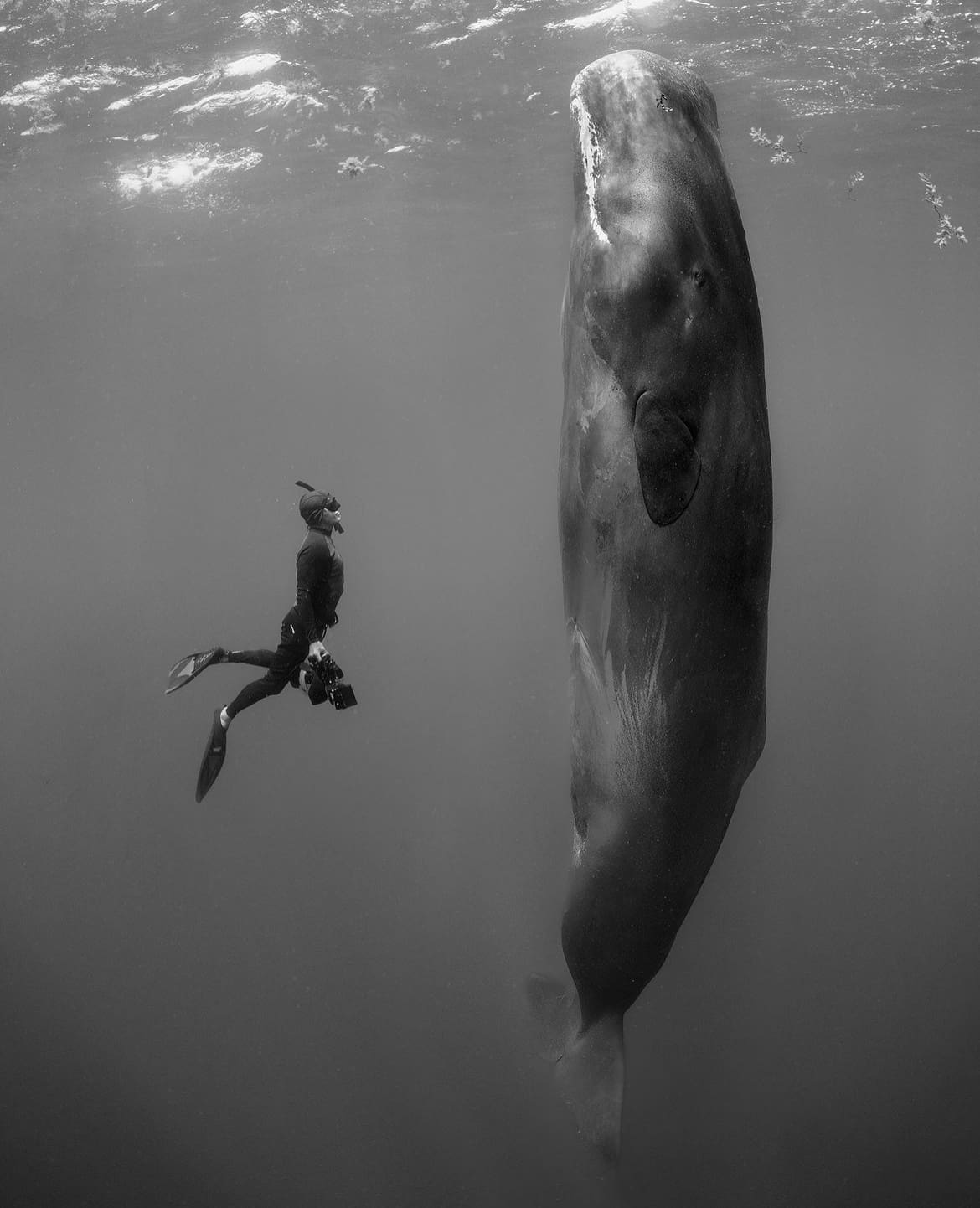
Tips for Spotting Sperm Whales
If you’re planning to embark on a sperm whale-watching adventure, here are a few tips to make your experience unforgettable. First, patience is key; these animals spend a lot of time deep underwater, so sightings can be unpredictable. Listen to the crew, as they’re skilled in spotting the telltale signs of a nearby whale, like their unique blow. Keep your camera ready, but also take time to observe them with your own eyes, soaking in the majesty of the moment. Lastly, respect the whales and the ocean; remember, we’re visitors in their home.
Facts about Sperm Whales
- Sperm whales can hold their breath for up to 90 minutes.
- They have the largest brain of any creature known to have lived on Earth.
- Their vocalizations, known as “clicks,” are the loudest sound produced by any animal and can be used for communication and echolocation.
- Sperm whales are found in all oceans, from the Arctic to the Antarctic.
Myths about Sperm Whales
- Moby Dick is not a typical representation: Herman Melville’s famous novel paints a picture of a ferocious beast, but sperm whales are generally not aggressive towards humans.
- They do not eat humans: There are no verified accounts of a sperm whale purposely attacking or eating a human.
- They cannot swallow a human whole: Despite their large size, the throat of a sperm whale is not large enough to swallow a human.
Sperm whales, with their awe-inspiring size, complex societies, and deep-sea exploits, are one of the ocean’s most fascinating inhabitants. Their story is one of resilience, navigating the challenges of the deep and the impact of human activity.
As we continue to explore and understand these magnificent creatures, let’s also commit to protecting them and their environment, ensuring that future generations can continue to be inspired by their grandeur and mystery.
The sperm whale’s journey through the vast oceans is a reminder of the interconnectedness of all life on Earth, urging us to look beyond our horizons and dive deep into the wonders of the natural world.
